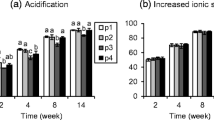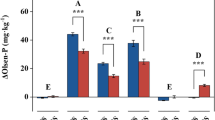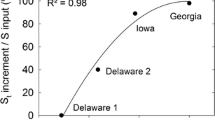Abstract
Although considerable progress has been made in relating extractable soil S to plant S availability, most of these studies determined the extractable soil S at the beginning of the experiment to use as an index of soil S status. This bears little or no relationship to the S taken up by plants during the entire growing season. The present study investigates the changes in extractable soil S with time and relates these to changes in plant S uptake. Six soils with different long-term fertiliser histories (0, 21, 42 kg of S as superphosphate ha−1 applied since 1952) and animal camping treatments (camp and non-camp) were used in two pot systems (with and without plants). Carrier-free 35SO4–S was added to the soils, to provide the information on the transformations of recently added S between the different extractable S forms in soils and whether these transformations could predict plant-available S. The soils were pre-conditioned and then transferred to the glasshouse, where one set of pots were planted with perennial ryegrass (Lolium perenne L.) while the other set was left uncropped. Periodic plant harvests and soil samplings at four weekly intervals were conducted over a period of 20 weeks to determine plant S uptake and amounts of extractable soil S and 35S forms using five extractants. Same extractions of soil S and 35S were conducted for the initial soils. Results showed that HI-reducible and total soil S extracted by CaCl2, KH2PO4 and by KCl at 40 °C were utilised significantly by plants but not those extracted by NaHCO3 and NaOH extractants. However, after the 8th week, plants continued to take up S even though levels of S extracted from the soil by CaCl2, KH2PO4 and by KCl at 40 °C remained low and unchanged. These results suggest that soil S taken up by plants after the 8th week period originated directly from the mineralisation of soil organic S from S pools other than those present in the extractable soil S forms. Similar results were shown by 35S data, thereby confirming the complexity of determining plant S availability based on soil S extraction methods.
Similar content being viewed by others
References
Anderson G C, Lefroy R D B, Chinoim N and Blair G J 1992 Soil sulphur testing. Sulphur Agric. 16, 6-14.
Barrow N J 1967 Studies on extraction and on availability to plants of adsorbed plus soluble sulfate. Soil Sci. 104, 242-249.
Bettany J R, Saggar S and Stewart J W B 1980 Comparison of the amounts and forms of sulphur in soil organic matter fractions after 65 years of cultivation. Soil Sci. Soc. Am. J. 44, 70-75.
Blair G J, Chinoim N, Lefroy R D G, Anderson G C and Crocker G J 1991 A soil sulfur test for pastures and crops. Aust. J. Soil Res. 29, 619-626.
Fieldes M 1968 General survey of the soils of South Island, New Zealand. Soil Bur. Bull. 27. New Zealand Department of Scientific and Industrial Research, Wellington, New Zealand.
Fox R L, Olsen R A and Rhoades H F 1964 Evaluating the sulfur status of soils by plant and soil tests. Soil Sci. Soc. Am. Proc. 28, 243-246.
Freney J R 1986 Forms and reactions of organic sulphur compounds in soils. In Sulphur in Agriculture. Ed. M A Tabatabai. pp 203-232. Agron. Mono. 27. Am. Soc. Agron., Madison, Wisconsin.
Freney J R, Melville G E and Williams C H 1975 Organic sulphur fractions labelled by addition of 35S-sulphate to soil. Soil Biol. Biochem. 3, 133-141.
Ghani A 1994 An overview of organic sulphur levels in New Zealand pastoral soils and methods for measuring the mineralizable pool of organic sulphur. Sulphur in Agric. 18, 13-17.
Ghani A, McLaren R G and Swift R S 1991 Sulphur mineralisation in some New Zealand soils. Biol. Fert. Soils 11, 68-74.
Ghani A, McLaren R G and Swift R S 1993 The incorporation and transformations of 35S in soil: effects of soil conditioning and glucose or sulphate additions. Soil Biol. Biochem. 25, 327-335.
Goh K M and Tsuji T 1979 Changes in soil sulphur fractions during incubation with and without added sulphur. New Zealand J. Agric. Res. 22, 585-594.
Haron K B and Hanson R J 1988 Sulphur supplying capacity of some Missouri soils. Soil Sci. Soc. Am. J. 52, 1657-1660.
Haynes R J and Williams P H 1992 Accumulation of soil organic matter and the forms, mineralization potential and plantavailability of accumulated organic sulphur: Effects of pasture improvement and intensive cultivation. Soil Biol. Biochem. 24, 209-217.
Hoeft R G, Walsh L M and Keeney D R 1973 Evaluation of various extractants for available soil sulfur. Soil Sci. Soc. Am. Proc. 37, 401-408.
Johnson C M and Nishita H 1952 Microestimation of sulfur in plant materials, soil and irrigation water. Anal. Chem. 24, 736-742.
Lee R and Speir T W 1979 Sulphur uptake by ryegrass and its relationship to inorganic and organic levels and sulphatase activity in soil. Plant Soil 53, 407-425.
Maynard D G, Stewart J W B and Bettany J R 1985 The effects of plants on soil sulfur transformations. Soil Biol Biochem 17, 127-134.
McLaren R G and Swift R S 1977 Changes in soil organic sulphur fractions due to the long term cultivation of soil. J. Soil Sci. 28, 445-453.
New Zealand Soil Bureau 1968 Soils of New Zealand. Part 3. Soil Bur. Bull., 26, 28-29.
Nguyen M L and Goh K M 1990 Accumulation of soil sulphur fractions in grazed pastures receiving long-term superphosphate applications. New Zealand J. Agric. Res. 33, 111-128.
Nguyen M L and Goh K M 1992a Status and distribution of soil sulphur fractions, total nitrogen and organic carbon in camp and non-camp soils of grazed pastures supplied with long-term superphosphate. Biol. Fert. Soils 14, 181-190.
Nguyen M L and Goh K M 1992b Evaluation of methods for determining sulphur-35 and sulphur-32 in the same trapping solution of Johnston and Nishita method. Commun. Soil Sci. Plant Anal. 23, 1893-1910.
Nguyen M L, Rickard D S and McBride S D 1989 Pasture production and changes in phosphorus and sulphur status in irrigated pastures receiving long-term applications of phosphorus fertiliser. New Zealand J. Agric. Res. 32, 245-262.
Pamidi J, Goh K M and McLaren R G 2001 Comparison of three different methods of determining soil sulphur mineralization in relation to plant sulphur availability in soils. Biol. Fert. Soils 34, 131-139.
Pirela H J and Tabatabai M A 1988 Sulfur mineralisation rates and potential of soils. Biol. Fert. Soils 6, 26-32.
Scott N M, Bick W and Anderson H A 1981 The measurement of sulphur-containing amino acids in some Scottish soils. J. Sci. Food Agric. 32, 21-24.
Sinclair A G and Enright P D 1982 An "autoanalyser" method for the determination of extractable soil sulphate using automated purification of extracts. New Zealand J. Sci. 25, 141-146.
Spencer K and Freney J R 1960 A comparison of several procedures for estimating the sulphur status of soils. Aust. J. Agric. Res. 11, 948-959.
Steinbergs A, Iismaa O, Freney J R and Barrow H J 1962 Determination of total S in soil and plant material. Anal. Chem. Acta 27, 158-164.
Tabatabai M A and Bremner J M1970 An alkaline oxidation method for the determination of total sulfur in soils. Soil Sci. Soc. Am. Proc. 34, 62-65.
Tan Z, McLaren R G and Cameron K C 1994 Forms of sulfur extracted from soils after different methods of sample preparation. Aust. J. Soil Res. 32, 823-834.
Taylor A R 1981 A method for surface irrigation design based on infiltration using the border strip as an infiltrometer. PhD Thesis, Lincoln University, New Zealand. 229 p.
Tsuji T and Goh K M 1979 Evaluation of soil sulphur fractions as sources of plant-available sulphur using radioactive sulphur. New Zealand J. Agric. Res. 22, 595-602.
Watkinson J H and Kear M J 1996 Sulfate and mineralisable organic sulfur in pastoral soils of New Zealand. I. A quasi equilibrium between sulfate and mineralisable organic sulfur. Aust. J. Soil Res. 34, 385-403.
Watkinson J H and Perrott K W1990 A new soil test for sulphate and mineralisable organic sulphur. Proc. New Zealand Fert. Manuf. Res. Assoc. Conf. pp. 189-198. Auckland, New Zealand.
Zhao F and McGrath S P 1994 Extractable sulphate and organic sulphur in soils and their availability to plants. Plant Soil 164, 243-250.
Author information
Authors and Affiliations
Corresponding author
Rights and permissions
About this article
Cite this article
Goh, K., Pamidi, J. Plant uptake of sulphur as related to changes in the HI-reducible and total sulphur fractions in soil. Plant and Soil 250, 1–13 (2003). https://doi.org/10.1023/A:1022823319406
Issue Date:
DOI: https://doi.org/10.1023/A:1022823319406




